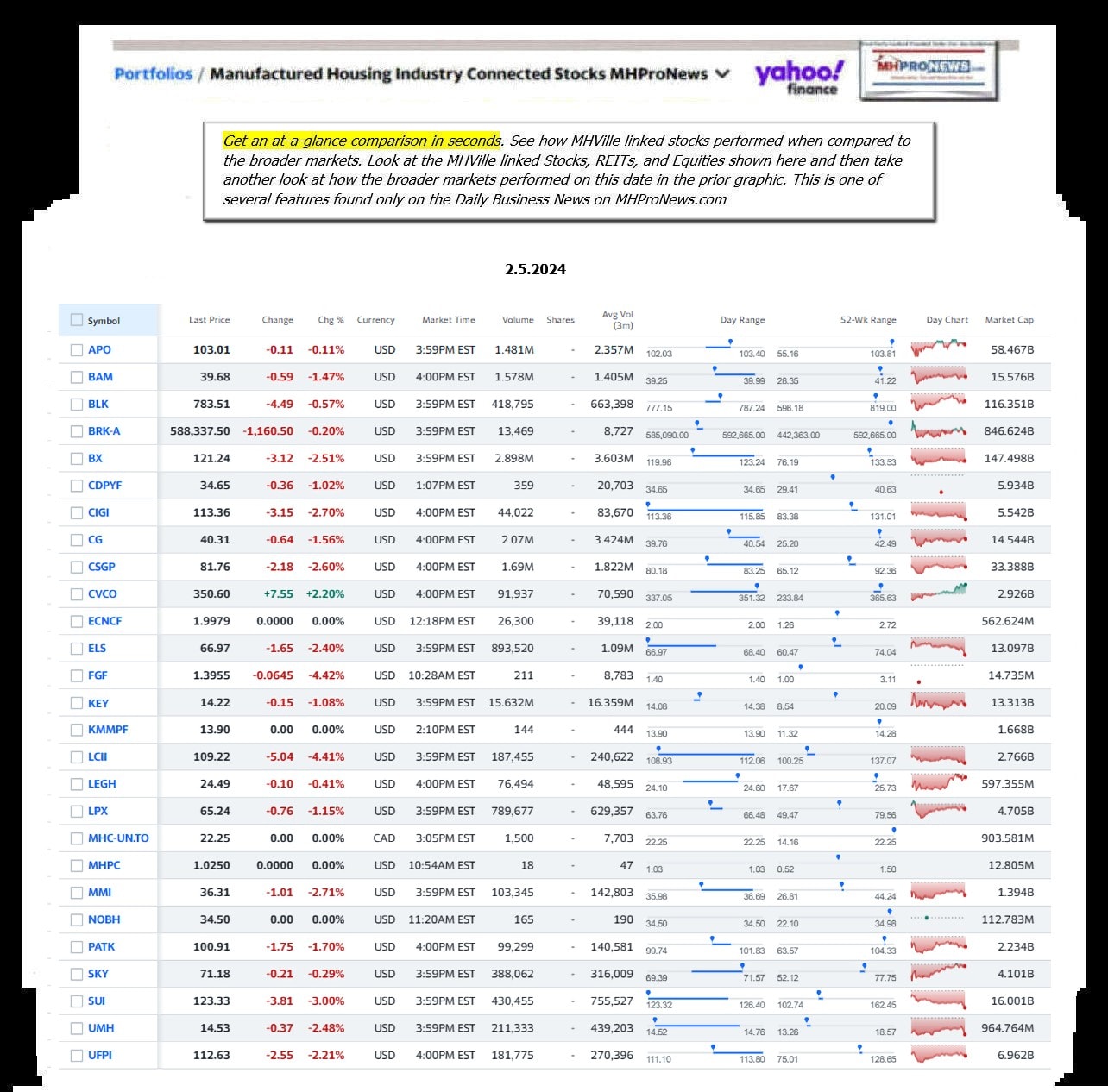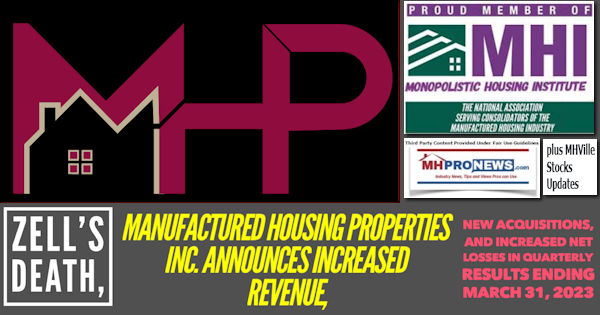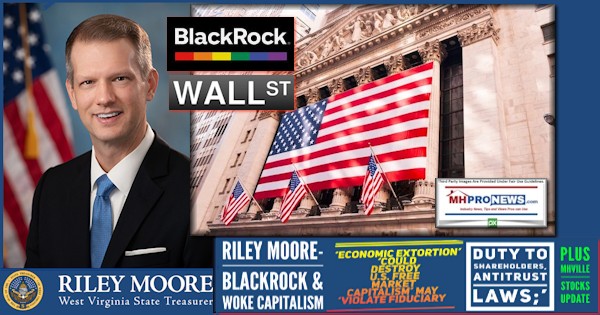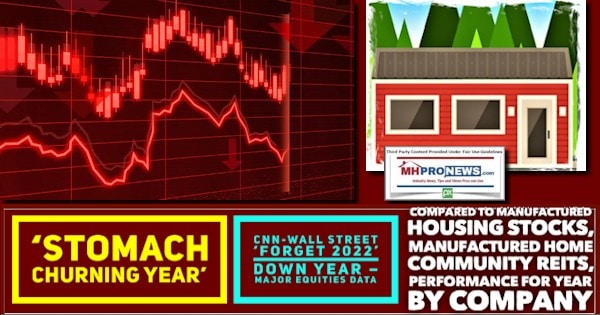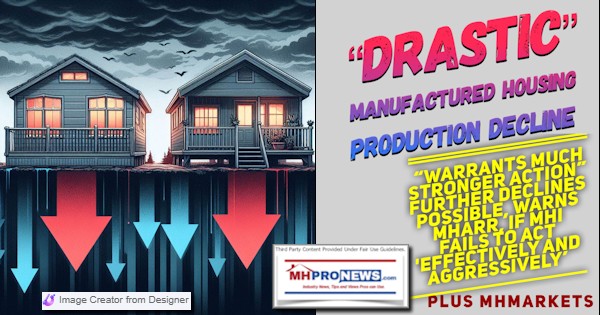
“The final 2023 production statistics reflect a continuing sharp decline in manufactured housing production and shipments that began during the final quarter of 2022 and has continued ever since,” said the Manufactured Housing Association for Regulatory Reform (MHARR) in a press release provided below by MHProNews. Oxford Languages defines “drastic” like this: “likely to have a strong or far-reaching effect; radical and extreme.” While the rate of decline was more modest in December, per the official data collected on behalf of the U.S. Department of Housing and Urban Development (HUD), the total year-over-year decline in 2023 vs. 2022 was 21 percent, said MHARR.
MHARR’s remarks in Part I include a call for the industry’s “national post-production representation” – an apparent reference to the Manufactured Housing Institute (MHI) – to end “failed” policies and talk and focus on “essential” effective and aggressive efforts, MHARR said. Their public pressure on MHI will be examined in Part II, because MHI’s leadership has on paper claims to want growth. Specific examples from MHI, MHARR, and other sources will be provided and explored in Part II along with MHProNews manufactured home industry expert analysis and commentary. Note that in the top 10 states graphic below, the MHARR logo and the MHProNews ‘third-party content’ disclosure logo are added, they are not in the original as found on the MHARR website at this link here. That noted, the text and content provided below are the same as provided by MHARR.
Part I
FOR IMMEDIATE RELEASE
Contact: MHARR
(202) 783-4087
Drastic 2023 Manufactured Housing Production Decline Warrants Much Stronger Action
Washington, D.C., February 5, 2024 – The Manufactured Housing Association for Regulatory Reform (MHARR) reports that according to official statistics compiled on behalf of the U.S. Department of Housing and Urban Development (HUD), HUD Code manufactured housing industry year-over-year production declined again in December 2023. Just-released statistics indicate that HUD Code manufacturers produced 6,360 new homes in December 2023, a .7% decrease from the 6,406 new HUD Code homes produced in December 2022. Cumulative production for 2023 thus totals 89,169 homes, a 21% decrease from the 112,882 HUD Code homes produced during 2022.
A further analysis of the official industry statistics shows that the top ten shipment states from January 2023 — with monthly, cumulative, current reporting year (2023) and prior year (2022) shipments per category as indicated — are:

The December 2023 statistics result in no changes to the top-ten shipment state list.
The final 2023 production statistics reflect a continuing sharp decline in manufactured housing production and shipments that began during the final quarter of 2022 and has continued ever since. This major decline, which would only be deepened and intensified by implementation of the draconian – and unnecessary — U.S. Department of Energy (DOE) May 31, 2022 “energy conservation” standards for HUD Code manufactured homes, represents an ongoing catastrophe for lower and moderate-income American families in need of inherently affordable housing and homeownership. This is especially the case in an environment where the cost of (non-HUD Code) homeownership has ballooned to historically high levels and the need for housing affordability of the sort provided by HUD Code homes has never been greater.
Aside from the impending DOE energy standards, which would only further undermine the industry and its ability to meet the nation’s dire need for affordable housing and homeownership, the sad reality is that the solution to most of the current production decline is actually quite straightforward. Put simply, the industry’s national post-production representation has failed, for far too long, to effectively and aggressively address and resolve the two main bottlenecks that have suppressed industry production and the availability of affordable manufactured housing – i.e., exclusionary zoning and the availability of competitive consumer financing, particularly within the industry’s dominant chattel lending sector. While the industry and its consumers have two good laws to correct these needless roadblocks – i.e., the enhanced preemption of the Manufactured Housing Improvement Act of 2000 and the Duty to Serve provision of the Housing and Economic Recovery Act of 2008 — the industry’s national post-production representation in Washington, D.C. has been unable to compel the full and proper implementation of these two laws. Accordingly, much stronger action by that representation is essential, while current and ongoing failures should be unacceptable to both the industry and consumers.
If the industry is to achieve any improvement in 2024 and beyond, all of these issues will need to be aggressively and effectively addressed, without apology, through strong defense, protection and advancement of the industry’s most affordable mainstream homes (rather than higher-priced substitutes) and strong advocacy on behalf of consumers and the industry. More meetings, conferences and seminars will not resolve these major bottlenecks. Much stronger action is long overdue.
The Manufactured Housing Association for Regulatory Reform is a Washington, D.C.- based national trade association representing the views and interests of independent producers of federally-regulated manufactured housing.
— 30 —
Manufactured Housing Association for Regulatory Reform (MHARR)
1331 Pennsylvania Ave N.W., Suite 512
Washington D.C. 20004
Phone: 202/783-4087
Fax: 202/783-4075
Email: MHARRDG@AOL.COM
Website: www.
##
Part II – Additional Information with More MHProNews Analysis and Commentary
Facts. Evidence. Common sense and logic. Each of those matters. Opinions matter as well, but opinions can be right, wrong, or somewhere in between. By contrast to opinions, facts are whatever they are.
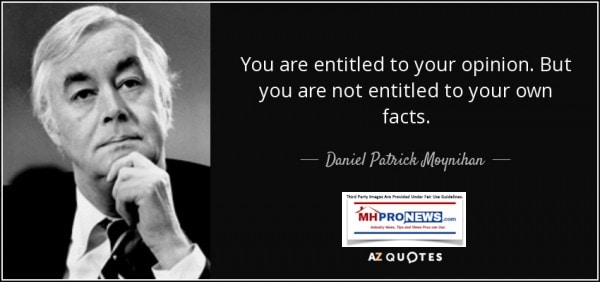
According to Bing’s AI powered Copilot: “Daniel Patrick Moynihan (1927–2003) was an American politician and diplomat. A member of the Democratic Party, he represented New York in the United States Senate from 1977 until 2001. His career spanned various roles, including serving as an adviser to President Richard Nixon [R], as the United States’ ambassador to India, and as the ambassador to the United Nations.” The R for Republican was edited in by MHProNews into the Copilot response because Nixon was a Republican.
Per Copilot:
- Moynihan’s famous saying, “You are entitled to your own opinion, but not to your own facts,” reflects his belief in the importance of evidence-based policymaking.
- He emphasized the need for objective data and rigorous analysis when formulating policies.
- This statement underscores the distinction between subjective viewpoints and verifiable facts, urging policymakers to base decisions on empirical evidence.
So, Moynihan had a history of being able to work ‘across the aisle’ based on evidence which some assert was part of his legacy.
As a disclosure, MHProNews is managed by political independents and believe in evidence-based decision-making where reasoning trumps mere opinion or ‘feel good’ emotions.
So, we have periodically used that Moynihan-attributed quote for years in various articles to illustrate that concept. Facts, evidence, and applied common-sense all matter. Ideally, our respective emotions can be harnessed to drive action that follows the evidence and reason. A further disclosure, already apparent to long-term readers of MHProNews, will occur later in this article.
With that predicate, let’s dive into the specific analysis of MHARR’s remarks about this roughly 15-months of documented decline in HUD Code manufactured housing production during a well-documented affordable housing crisis.
1). Regarding the U.S. affordable housing crisis, prominent MHI member Cavco Industries (Cavco’s William “Bill” Boor is their current executive committee and board chairman) has said:
- that some 6 million housing units are needed
- home “Ownership helps prevent intergenerational poverty”
- and the “Shortage of affordable housing cost American economy 2T [i.e.: 2 trillion dollars annually] in lower wages and productivity”
Each of those items noted by Cavco are demonstrably true, and in some ways, perhaps that shortfall of 6 million housing units is understated by several million. More on the Cavco claims bulleted above will be provided further below because facts, evidence, and applied common sense all matter.
2). For years, the Manufactured Housing Institute (MHI) asserted on their website that they represent “all segments” of the manufactured home industry or the “factory-built housing” industry. MHI said something similar in their annual IRS Form 990 filing, which is reviewed by their board of directors each year and is sworn to by the MHI president under penalties of perjury.
More specifically, MHI has said to the IRS in their 990 filing that their mission is to: “Improve the overall operating environment for the manufactured housing industry and expand the demand for manufactured homes by seeking fair and equitable treatment in the marketplace and the regulatory and legislative arenas.”

3). Per Bing’s AI powered Copilot, which cited MHProNews as a source for the information below, for manufactured home production from the years 1995-2022. Note that MHProNews in turn cited MHARR and official data collected by IBTS for HUD as the source for the follow facts. Then Copilot was asked to add the year 2023, per MHARR’s published report.
Here are the total U.S. HUD Code manufactured housing production from 1995 through 2023. Quoting Copilot’s response:

Table
| Year | Production |
|---|---|
| 1995 | 344,930 |
| 1996 | 363,345 |
| 1997 | 353,686 |
| 1998 | 373,143 |
| 1999 | 348,075 |
| 2000 | 250,366 |
| 2001 | 193,120 |
| 2002 | 165,489 |
| 2003 | 130,815 |
| 2004 | 130,748 |
| 2005 | 146,881 |
| 2006 | 117,373 |
| 2007 | 95,752 |
| 2008 | 81,457 |
| 2009 | 49,683 |
| 2010 | 50,056 |
| 2011 | 51,618 |
| 2012 | 54,881 |
| 2013 | 60,228 |
| 2014 | 64,334 |
| 2015 | 70,544 |
| 2016 | 81,136 |
| 2017 | 92,902 |
| 2018 | 96,555 |
| 2019 | 94,615 |
| 2020 | 94,390 |
| 2021 | 105,772 |
| 2022 | 112,882 |
| 2023 | 89,169 |
4). In graphical form that table above looks like the chart below. So, that data is from 1995 to 2023. Note the sharp plunge from the high of 373,143 in 1998 to the 89,169 new HUD Code manufactured homes produced in 2023.

5). MHI can’t have it both ways. They logically can’t escape their share of responsibility for the manufactured home industry’s performance. If the industry is doing well, they merit a share in that glory. But if the manufactured home industry is doing poorly, MHI must shoulder some responsibility. Indeed, MHI board members arguably have a ‘fiduciary responsibility‘ for the association’s performance.
Some have argued, that not only does MHI shoulder some responsibility for the industry’s poor performance, but they also shoulder a measure of liability. Given their respective fiduciary duties, that is reasonable.
In their own words, they insist that they are: “The Manufactured Housing Institute is the only national trade organization representing all segments of the factory-built housing industry. We are your trusted partner, advocate and industry leader.” “Grow your business Get the tools, platform and information you need.” But isn’t it obvious – based on the known facts – that it is more difficult to ‘grow a business’ when manufactured home industry production is shrinking?
Isn’t it apparent that it is impossible to accomplish: “Expanding Attainable Homeownership” when the manufactured home industry is in 15 months of year-over-year declining production?
To put it politely, MHI’s platitudes and catch-phrases sound like campaign slogans that a partisan politician may utter, hoping that friendly (i.e.: partisan) media won’t fact check them on their claims. Note that partisan media in the 21st century may downplay or ignore the weaknesses of a given candidate from ‘their’ party and may overemphasize the strengths or slogans that ‘their’ candidate’s campaign pitch makes. To better understand that process, see the detailed report linked below.
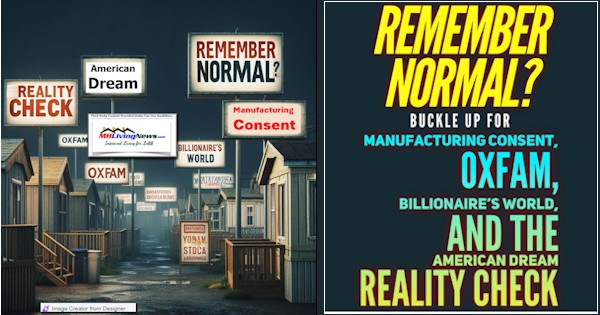
6). With those facts in mind, here are some additional observations framed in connection to remarks by MHARR.
Note that a 21 percent drop in year over year production any industry would be considered a “major decline.” Note that as measured by the last peak of U.S. HUD Code manufactured home production of 373,143 achieved in 1998 compared to the current production of 89,169 is: 0.23896736639 or only about 24 percent (less than 1/4th) of the high from 26 years ago. Meaning, there has been a 76 percent decline in new manufactured home production.
According to the U.S. Census Bureau: “The United States population on January 31, 2024 was: 336,000,099 select date.” But the United Nations (U.N.) data reflects a higher U.S. population, perhaps because of the flow of illegal immigration into the U.S. that may not be reflected by the Census Bureau data. Whatever the motivations and causes for that discrepancy between U.S. and U.N. data, having noted it, consider this Q&A with Copilot.
> “What is the estimated U.S. population in 2024 vs. the U.S. population in 1998? How much has the population grown percentage wise during those years?”
Learn more
> “HUD Code manufactured home production in 1998 was 373,143 dwellings. In 2023 HUD Code manufactured home production was 89,169, both based on official sources deemed reliable for this purpose. What is the percentage of drop in production since 1998 to 2023? Had the production of HUD Code manufactured housing grown during that same timeframe at the same rate as the population, what would manufactured housing production be today?”
Learn more
7). MHARR’s press release provided in Part I above used the term “major decline.” Clearly, in any reasonable sense of the expression, a 76 percent drop since 1998, and a 21 percent year-over-year decline from 2022 to 2023 is “major.” Then, MHARR stressed that the looming DOE energy rules issue could make the production fall worse if that threat isn’t abated by MHI.

To see a more detailed look at that DOE issue, click on the linked report with analysis below.
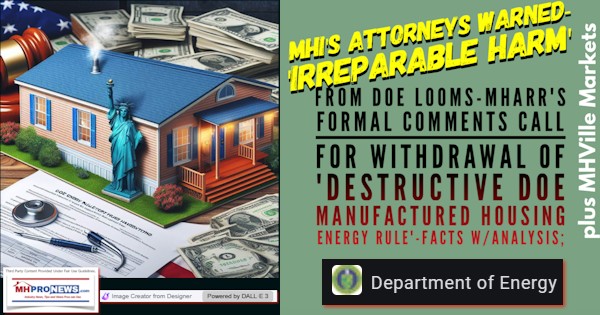
8). MHARR’s press release said on 2.5.2024: “Aside from the impending DOE energy standards, which would only further undermine the industry and its ability to meet the nation’s dire need for affordable housing and homeownership, the sad reality is that the solution to most of the current production decline is actually quite straightforward.”
Specifically, MHARR pointed to the need to robustly enforce existing federal laws.

To put that differently, this isn’t a case of needing new legislation. The existing legislation could be fine. But MHI apparently has not only fumbled on pressing for the proper and robust enforcement of existing laws. In some instances, they have undermined it, says MHARR. As MHARR’s President and CEO, Mark Weiss said last summer, MHI CEO Gooch’s remarks to the FHFA listening session were ‘inexcusable and a major problem.’
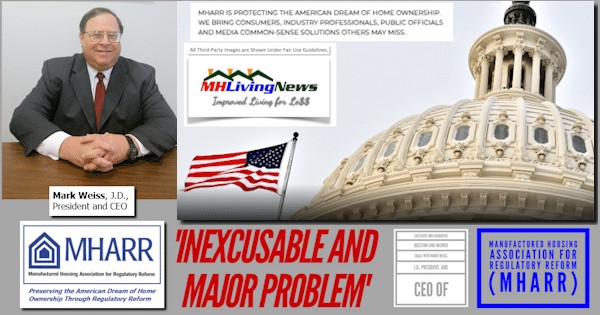
9). Then MHARR said more meetings and seminars – perhaps meaning, more posturing, projecting, and preening – won’t fix this issue.

MHARR offered to help MHI on the DOE energy lawsuit. Per sources, and MHARR’s published remarks, MHI didn’t respond. MHARR offered to work with an MHI-linked state association to litigate the “enhanced preemption” provision of the Manufactured Housing Improvement Act of 2000 (MHIA or what MHARR sometimes calls the 2000 Reform Law). No state association responded.
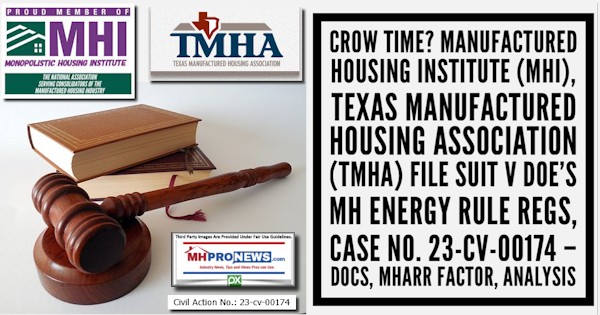
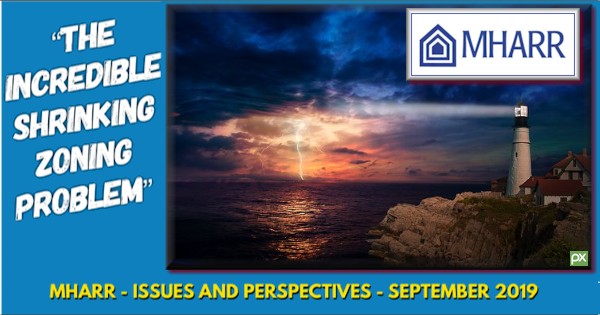
As the post above linked to the MHARR website reflects, MHARR pushed for that during the Trump Administration’s push for regulatory reforms. A close reading of MHARR remarks on their website during the waning years of the Trump era reveal their concern that MHI was trying to “run out the clock” on the Trump Administration’s efforts for regulatory reform with respect to manufactured housing.
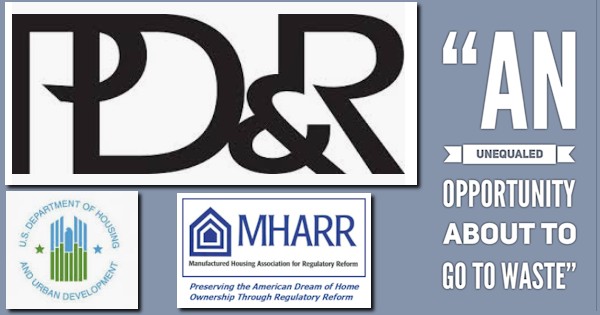
All the while, MHI kept up the ‘dog and pony show’ of high-profile meetings with the Trump Administration, with members of Congress, etc.
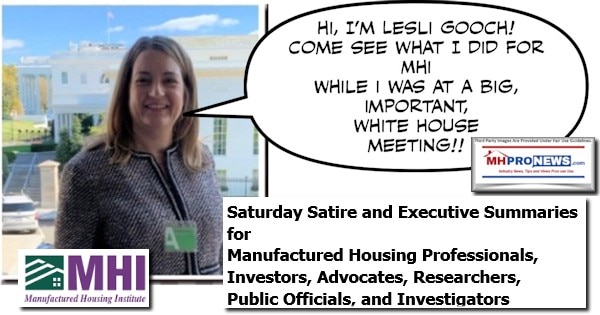
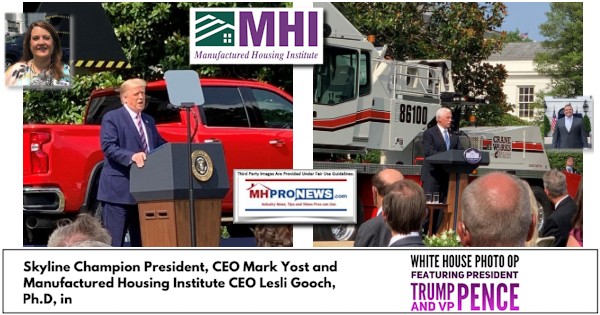
As the first of those two posts linked above reflect, MHProNews editorially essentially mocked MHI’s then EVP, now CEO, Lesli Gooch for their posturing. Why? Because based on their 21st century history, MHI’s ‘efforts’ were bound to lead nowhere. In a sense, MHI’s leaders – corporate and senior staff – needed and deserve to be mocked, because they were squandering an opportunity, just as MHARR asserted at the time. With mocking in mind, consider this Q&A with Copilot.
> “Can mocking some organization to make a point be effective?”


10). Beyond satire, stating the obvious is another effective and potentially important way to convey a message. MHProNews is a for-profit business. Our parent company has been profitable for 14 years. According to Copilot, which cited the Small Business Administration (SBA), only 25 percent of all startups survive 15 years. While we were already experienced and award-winning in several aspects of manufactured housing (street retail, land-lease communities, etc.), MHProNews launched in mid-October 2009 with what in hindsight was an admittedly naïve viewpoint. What was that frankly naïve view we held back in 2009?
Manufactured housing was obviously struggling to sell more homes and was in a historic decline.
The naïve view we held back was the apparently mistaken belief that this writer had that there was an apparent need to inspire the manufactured home industry with information and methods that could lead to serious industry growth. More on that shortly.
Naturally, as with any business venture, our business plan included making money while we inspired, informed, and provided a digital trade platform that filled the void once filled by the previously dominating trade publication, the Manufactured Home Merchandiser Magazine. After the MH Merchandiser announced that they would close, we opened what today is called MHProNews within 90 days. Note that 2009 was the year that the industry hit bottom. Several manufactured home trade media closed before the Merchandiser did. Chris Olvera, the editor for the Merchandiser was among those who had warm and encouraging words when we launched. See the chart above (Part II #4) to grasp the manufactured housing market and the context for Part II #10, reproduced below with some additional arrows added to it. As Kevin Clayton noted in remarks to Congress, thousands of other manufactured home industry closures occurred; it wasn’t just trade publications. The facts are illustrated below.
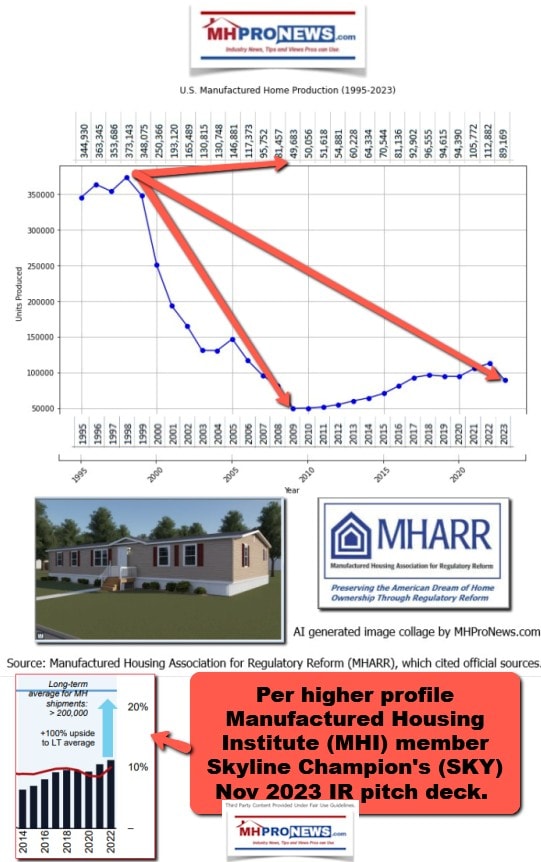
Note: to expand this image below to a larger or full size, see the instructions
below the graphic below or click the image and follow the prompts.
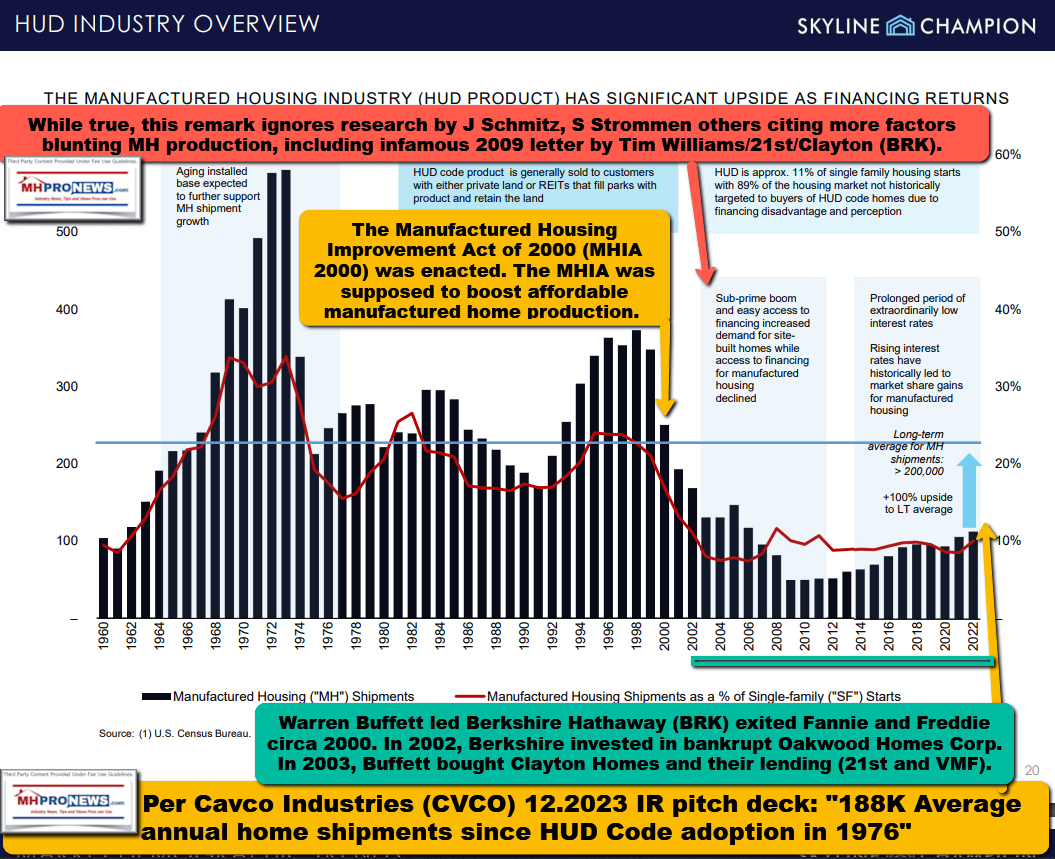

That thought, that sincere belief, that virtually all manufactured home industry leaders would want to see the manufactured housing industry grow turned out to be naïve. Despite what MHI claims on their website and in their IRS Form 990 filing, there is ample evidence to the contrary. The most recent example reported is found in the report linked below the illustration from prominent MHI member, Equity LifeStyle Properties (ELS).
Note: to expand this image below to a larger or full size, see the instructions
below the graphic below or click the image and follow the prompts.
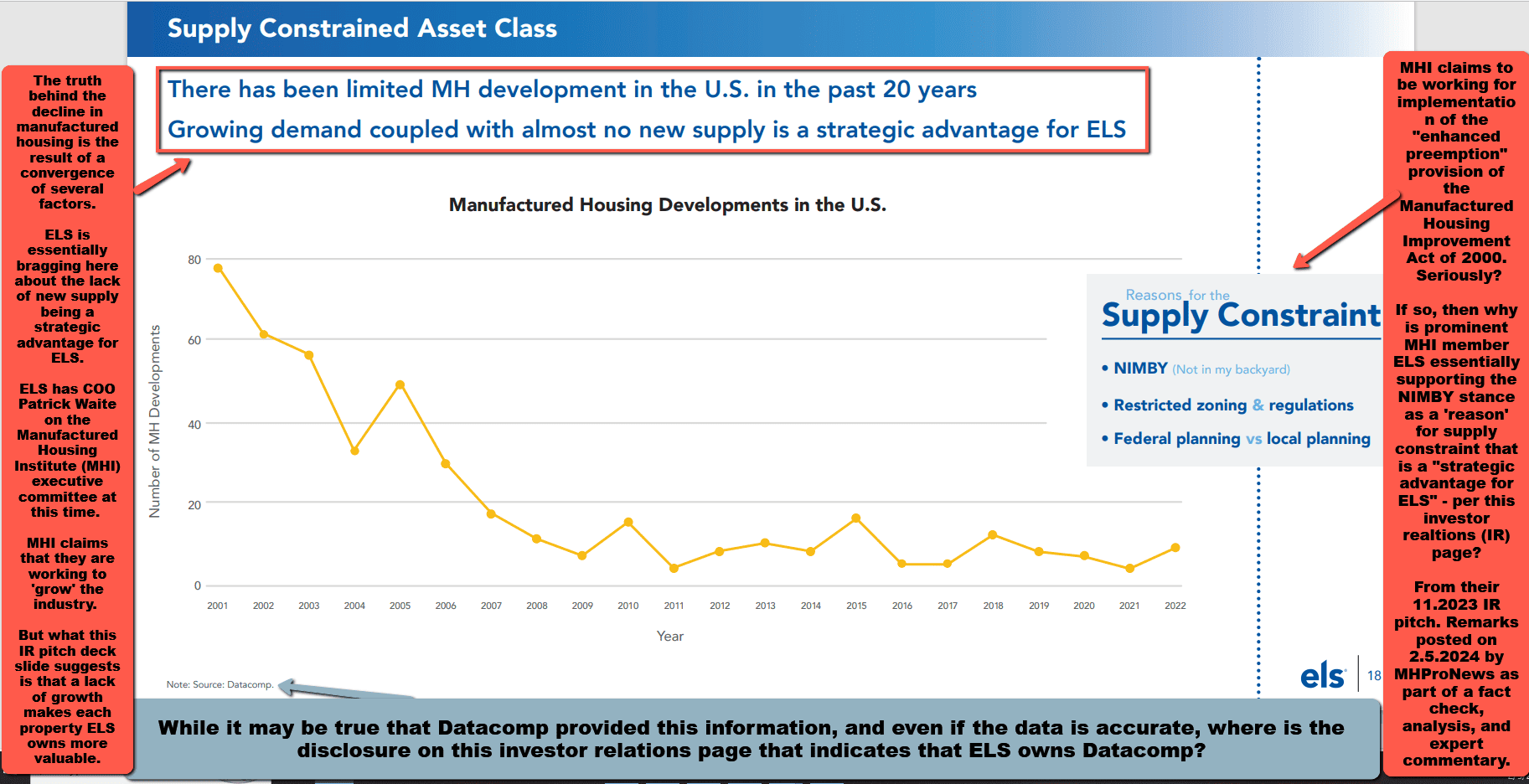
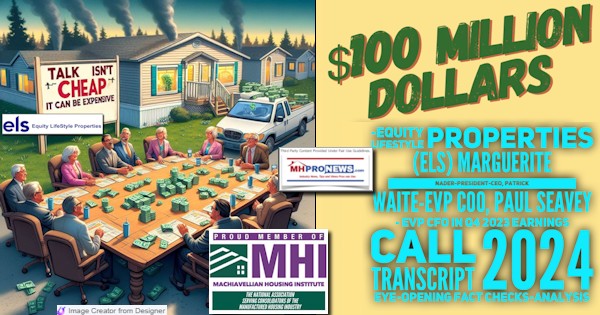

Can MHI leaders’ spell “Oops”…?

It is simply not plausible that MHI’s leaders are unaware of the disconnect between what MHI claims via email, via the internet, via the U.S. Mail, and via IRS Form 990 filings and what several of their board members have said about industry consolidation. Among the documents that MHI used to have available on their website that vanished one fine day from public access is this one. It shows the consolidation track of MHVille, as once reported by MHI.
Note: to expand this image below to a larger or full size, see the instructions
below the graphic below or click the image and follow the prompts.
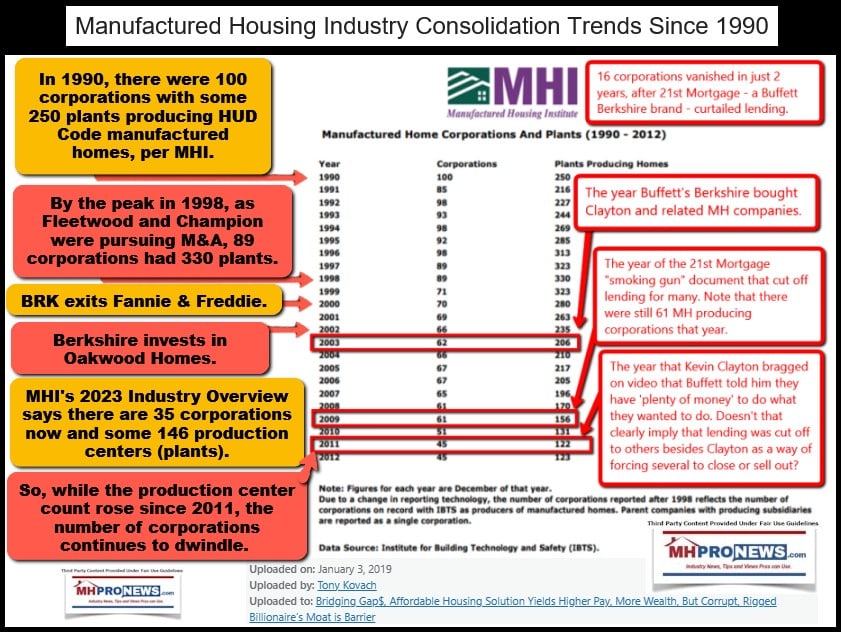
To be candid, several people in MHVille had cautioned me against believing what MHI said at face value. Back then, I thought them mistaken. I’ve since had to admit that they were correct and that MHProNews (i.e.: this writer) was the one who erred in taking at face value what MHI said. Journalistic skepticism was warranted. Why MHI leaders have and continue to ignore apparent conflicts of interest is stunning, once the micro and macro pictures are understood.


While this writer had witnessed prior to launching MHProNews apparently dishonest and/or corrupt behavior in manufactured housing, it simply didn’t seem plausible circa a decade or more ago that the largest manufactured home industry trade group and its board leaders would be involved in limiting their own industry’s production and performance. See the collage of current and years of prior MHI board leaders at this link here.
Ironically, part of my ‘aha moment’ or wake up process was the moment when this video was shot with Richard “Dick” Jennison, who was then the President and CEO of MHI.
Imagine if a leader at NAR, NAHB, or MHARR said – ‘let’s grow, but let’s do it slowly.’ How long would they keep their job? But Jennison kept his job until he retired. MHI CEO Gooch has kept her job, despite the controversies and documentary evidence against her, how is that possible? There is a question if the documentary tips about Gooch came from current MHI President Mark Bowersox?!? Why haven’t outside or inside MHI connected attorneys acted?
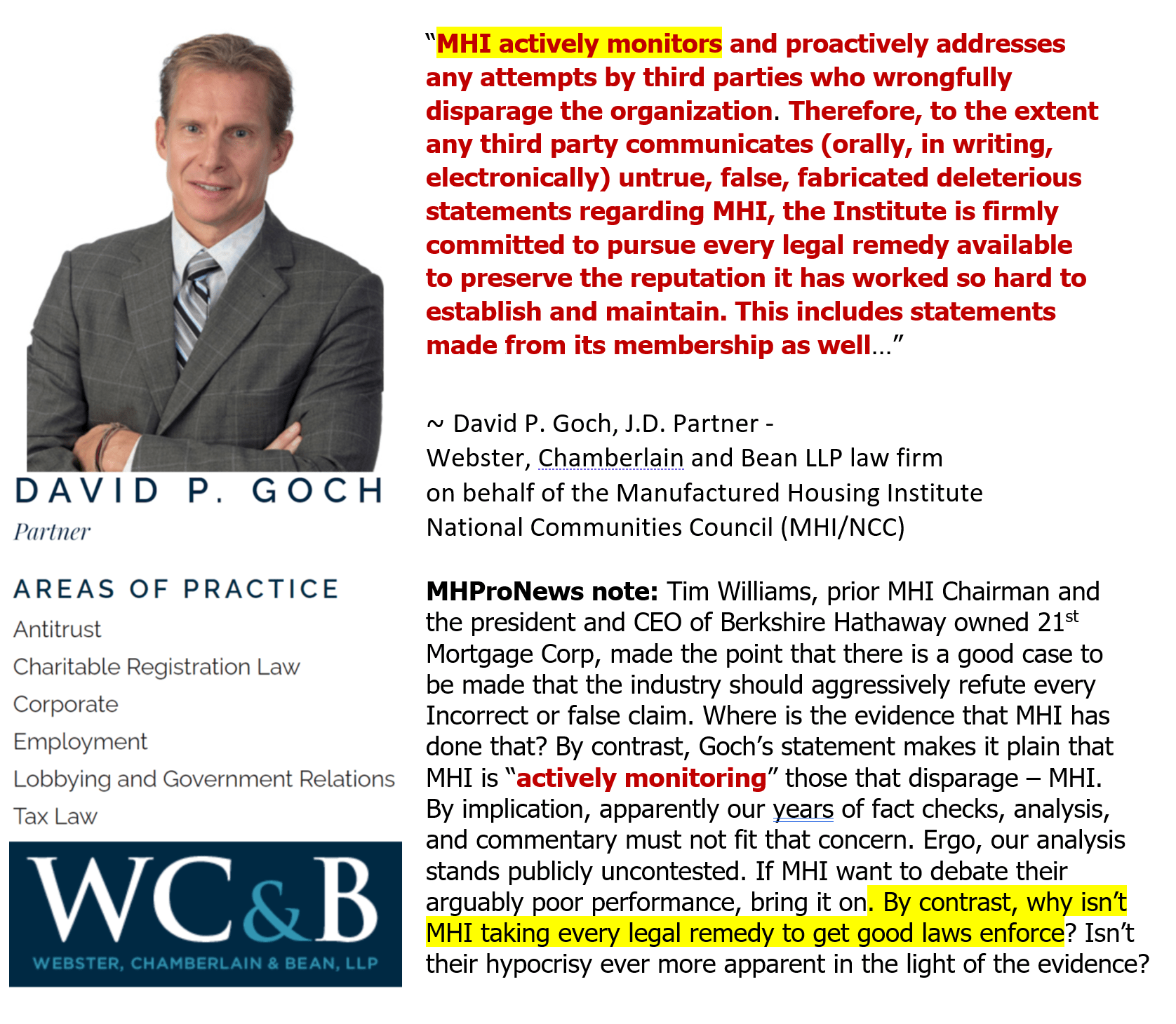
11. A tipster later told MHProNews that an MHI message to their members was factually accurate, but nevertheless misleading. How so? It was an apparent example of paltering. MHI provided via email a message to their members that was contradicted by the full-length version of the exchange in Congress about the now long defunct Preserving Access to Manufactured Housing Act.
More recently, just last month MHI issued an email to their members that did something arguably similar. When Bing’s AI powered Copilot was asked to examine what MHI wrote in their email to industry members, and what the Congressional record of the same event said, Copilot said that MHI’s remarks fit the definition of a ‘lie,’ ‘deception,’ and ‘misinformation.’
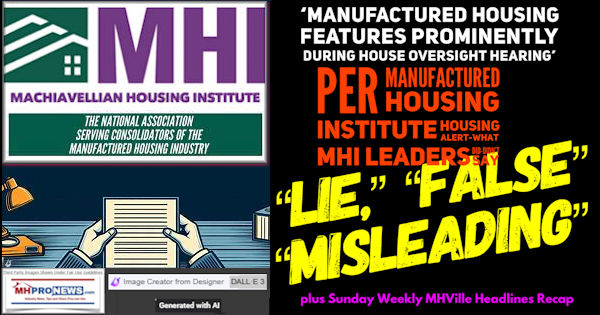
12). During the term of most of the time that Richard “Dick” Jennison was the President and CEO of MHI, MHI used to respond to MHProNews inquiries in a timely, and sometimes swift manner. Something similar was true while Thayer Long led MHI. Jennison and Long would respond on behalf of MHI to our trade media inquiries, much as MHARR did to emailed or telephone inquiries. Indeed, all of them coveted the coverage and in some sense could be said to have cultivated our coverage, perhaps because we were (and apparently remain) the largest known trade media platform serving the manufactured home industry. So, what changed during the later part of the Jennison era at MHI, and what is now the Mark Bowersox (MHI President) and Lesli Gooch (MHI CEO) era that MHI has dubbed “MHI 2.0”?
MHI won’t say. They have gone from praising us, to having members of our team on MHI panel discussions, to what might be described as unofficially blacklisting us. Indeed, an MHI linked blogger, George Allen publicly called for a boycott, which can be an antitrust violation. There is more that could be said, but in brief, it seems that MHI leaders may have wanted to drive us out of business. That was after Jennison approached MHProNews more than once to buy our publication on behalf of MHI for potentially millions of dollars – statements that can be documented.
To illustrate how relatively chummy MHI leaders were with MHProNews prior to our awakening and asking questions that they apparently wanted to avoid, 21st Mortgage Corporation leader Tim Williams, who was also a former MHI chairman and is a longtime MHI board member, praised our publications. When Williams was asked by MHProNews about the clumsy video remarks uttered by Jennison in the video above in Part II #10, Williams apparently arranged to have Jennison clean it up at the next Louisville Show with a live audience where Jennison also praised MHProNews.
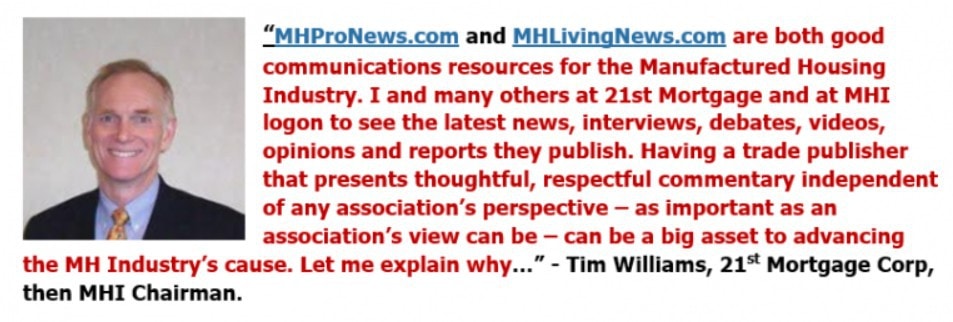
13). At that same Louisville address by Jennison, he remarked that the manufactured housing industry should set its goal as 500,000 new HUD Code homes per year. That’s captured on video. Note that about the time that MHProNews began publicly questioning MHI leaders, MHI and several of their members were sponsors of our site. So, right or wrong, MHProNews has at times questioned MHARR (now a sponsor) and has questioned MHI and some of their larger members too. Smart or dumb, we did what trade media and all honest news sources should do – hold the powerful to account. We of course try to serve a sponsor’s needs properly, but if ‘bad news’ involving a sponsor(s) broke, we have asked the hard questions, reported accordingly, and held them to account. Can mainstream media always say the same? Can any pro-MHI bloggers or trade media say the same?
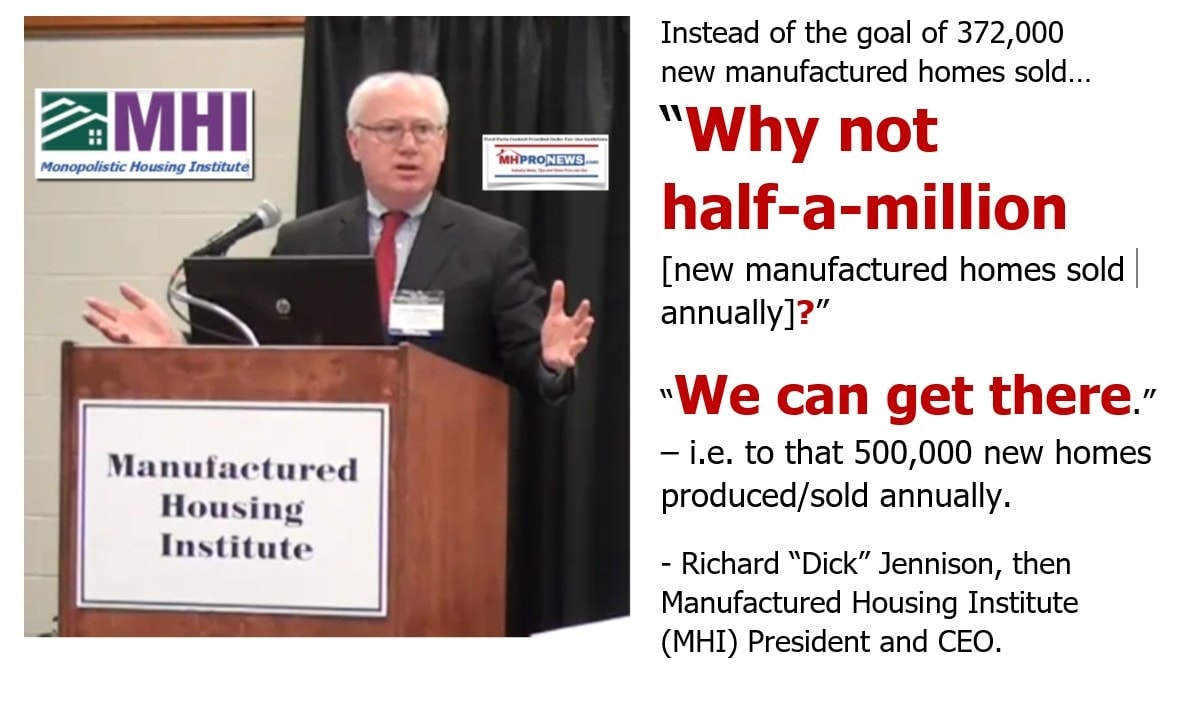
Note too while MHARR and MHProNews often see the world similarly now, we are independent entities.
14). Let’s sum up to this point. MHI claims that it wants industry growth. MHI has said so under penalties of perjury. Those IRS Form 990 remarks have purportedly been reviewed by the MHI board and by various attorneys. Perjury can result in criminal charges. Suborning perjury can result in disbarment. Is it any wonder why MHI stopped responding to inquiries by MHProNews, given that almost anything that they said would result in an obvious contradiction with known evidence?




15). Let’s pivot back to the specific data for 2023. In Part 2 #6, Copilot said: “Therefore, if manufactured housing production had grown at the same rate as the population, it would be approximately 446,117 dwellings today.” The MHIA’s enhanced preemption provision, combined with the DTS – both cited by MHARR in their press release provided in Part I, were supposed to GROW the industry, not keep it at a status quo. But even if the same percentage of production had kept pace with the population, manufactured housing would stand at 446,117 new HUD Code manufactured homes in 2023, instead of the 89,169 new homes that were actually produced last year. Per Bing: 446,117 – 89,169 =356,948.
If manufactured housing had produced 200,000 new homes more in the 21st century, how many more homes would have been built? MHProNews asked Copilot. After clearing up a miscommunication, Copilot said the following.

The 21st century started in the year 2001 and ends in the year 2100. We’ll consider the period from 2001 to 2023 (inclusive).
The total number of years in this period is:
[ \text{Years} = 2023 – 2001 + 1 = 23 ]
Now, let’s find the total additional homes:
[ \text{Additional homes} = 200,000 \times \text{Years} = 200,000 \times 23 = 4,600,000 ]
Therefore, if 200,000 more homes were produced in each year of the 21st century through the year 2023, there would have been a total of 4,600,000 additional manufactured homes built. …”
16). Note that Cavco argued that the lack of some 6 million homes was costing the U.S. economy about $2 trillion dollars annually. Copilot’s math tells us that the industry might have 4.6 million more homes today had just 200,000 more HUD Code manufactured homes been built. That means that instead of the U.S. losing $2 trillion in lost GDP for 2023, that gap would have been reduced by 0.766666667. So instead of a $2 trillion dollar loss to the GDP, there would have been some $1,533,333,334,000 more GDP. Which means that applying Cavco’s IR pitch logic the shortfall in 2023 would have only been $466,666,666,000.
Note: to expand this image below to a larger or full size, see the instructions
below the graphic below or click the image and follow the prompts.
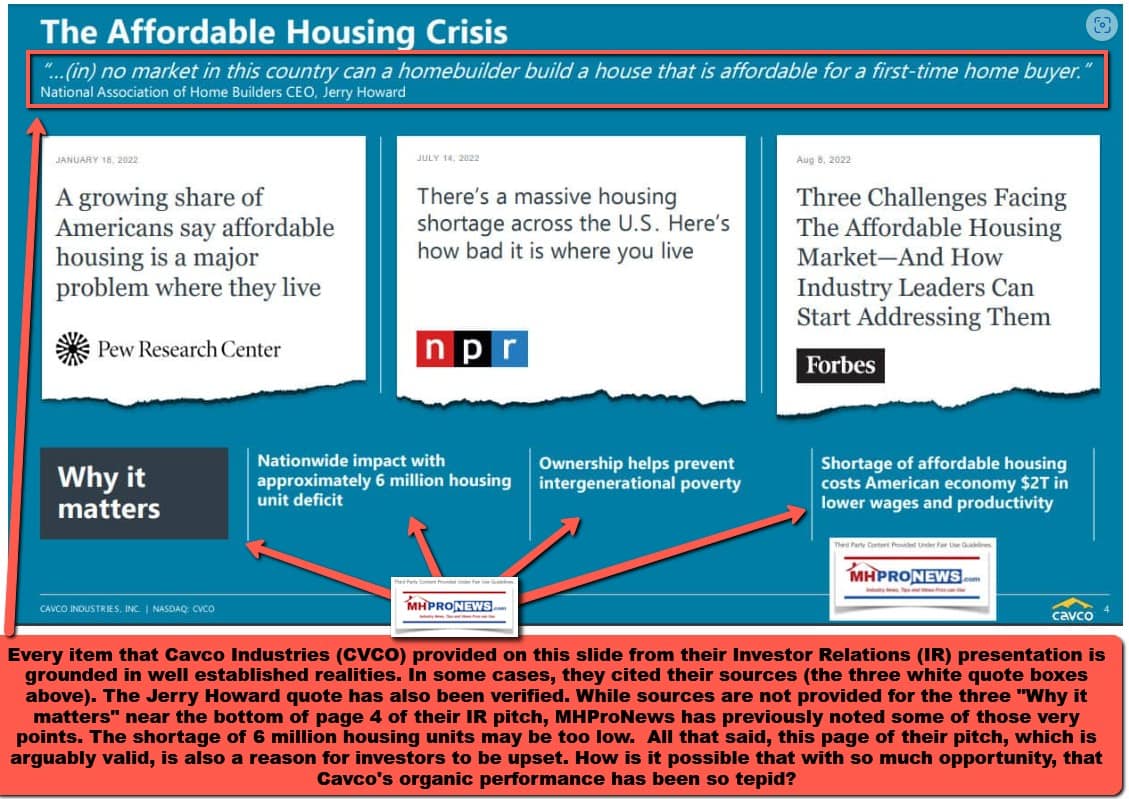
What that math could mean is this. If federal officials, or some law firm(s) with giant cojones, decided to press a civil case against arguably corrupt brands in manufactured housing, the impact could conservatively be $466.67 billion dollars. Berkshire and some of the larger firms involved in manufactured housing might theoretically be able to cough that up. Would that battle take years? Of course. Is it an automatic? Obviously, juries and judges are not entirely predictable. But it is plausible. Given the growing number of antitrust suits already pending against some MHI member firms, it is not as hard to imagine as it was 5 years ago when MHProNews began to beat the drum that legal accountability is needed in MHVille.
17. The research, evidence, reasoning, and logic of Sam Strommen and Daniel R. Mandelker are just some of those who’s published remarks in some sense arguably supports the concerns lodged by MHARR. Strommen said MHI is apparently guilty of “felony” antitrust violations.
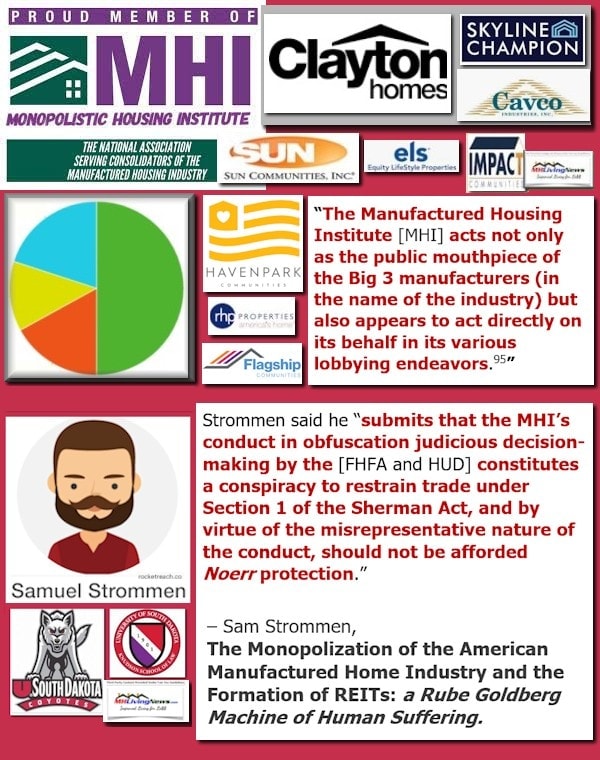


Closing Thoughts, Summary and Conclusion
Much more could, and perhaps will be observed about the data above. But that is sufficient to demonstrate the following.
- MHARR’s concerns are based upon solid evidence. “The final 2023 production statistics reflect a continuing sharp decline in manufactured housing production and shipments that began during the final quarter of 2022 and has continued ever since.”
- MHARR’s MHI appears to be failing the industry big time. That is the apparent meaning of MHARR’s remark about the industry’s “national post-production representation” i.e.: MHI.
- On and off the record, sources at MHARR have at times mused that what they want is for MHI to step up and dig in to do their blankety blank jobs. MHI should do what they claim. See Sunday’s report.
- MHARR said: “all of these issues will need to be aggressively and effectively addressed, without apology, through strong defense, protection and advancement of the industry’s most affordable mainstream homes (rather than higher-priced substitutes) and strong advocacy on behalf of consumers and the industry. More meetings, conferences and seminars will not resolve these major bottlenecks. Much stronger action is long overdue.”
Amen.
Authentic action vs. posturing and propaganda is long overdue.
As usual, MHI leaders are invited to respond to the concerns outlined herein. Per sources deemed reliable, MHI board and staff leaders are routinely among our regular MHProNews readers. We will dig deeper in the day ahead and can provide any remarks that they might make. ##
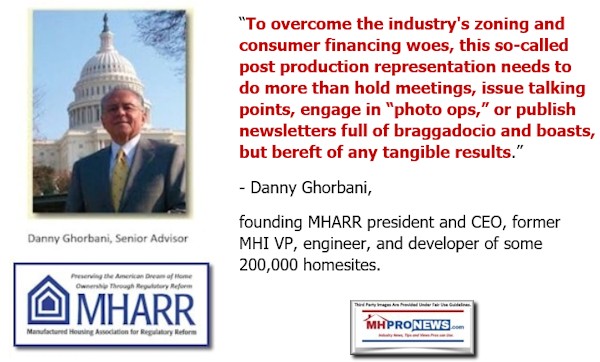


Part III – is our Daily Business News on MHProNews stock market recap which features our business-daily at-a-glance update of over 2 dozen manufactured housing industry stocks.
This segment of the Daily Business News on MHProNews is the recap of yesterday evening’s market report, so that investors can see at glance the type of topics may have influenced other investors. Thus, our format includes our signature left (CNN Business) and right (Newsmax) ‘market moving’ headlines.
The macro market move graphics below provide context and comparisons for those invested in or tracking manufactured housing connected equities. Meaning, you can see ‘at a glance’ how manufactured housing connected firms do compared to other segments of the broader equities market.
In minutes a day readers can get a good sense of significant or major events while keeping up with the trends that are impacting manufactured housing connected investing.
Reminder: several of the graphics on MHProNews can be opened into a larger size. For instance: click the image and follow the prompts in your browser or device to OPEN In a New Window. Then, in several browsers/devices you can click the image and increase the size. Use the ‘x out’ (close window) escape or back key to return.
Headlines from left-of-center CNN Business – from 2.5.2024
- CNN overhauls morning show lineup under new CEO amid sagging ratings
- Tesla cars sit in a dealership lot on March 28, 2022 in Chicago, Illinois.
- Tesla stock drops as investors scrutinize board’s close personal ties to Elon Musk
- The headquarters for the Boeing Company is seen on February 2, 2024, in Arlington, Virginia.
- New problem found on Boeing 737 Max planes
- Boeing was once known for safety and engineering. But critics say an emphasis on profits changed that
- Sundar Pichai, CEO of Google and Alphabet, takes part in a discussion at the Asia-Pacific Economic Cooperation (APEC) CEO Summit Nov. 16, 2023, in San Francisco.
- DOJ antitrust case targeting Google’s ad-tech business will go to trial in September, federal judge rules
- Federal Reserve Chair Jerome Powell during a CBS “60 Minutes” interview on Sunday night.
- Stocks sink after Fed Chair Powell pleads for patience on rate cuts
- Harvard University in Cambridge, Massachusetts, on December 12, 2023.
- Harvard candidates backed by Bill Ackman and Mark Zuckerberg fail to get on the ballot for board election
- Jay Shambaugh, under secretary for international affairs at the US Department of the Treasury, during a Senate Foreign Relations committee hearing in Washington, DC, US, on Wednesday, July 26, 2023.
- US sends top Treasury officials to China to discuss economy
- A man walks his dog on the edge of the Los Angeles River, carrying stormwater downstream Sunday, Feb. 4, 2024, in Los Angeles. The second of back-to-back atmospheric rivers battered California, flooding roadways and knocking out power to hundreds of thousands and prompting a rare warning for hurricane-force winds as the state braced for what could be days of heavy rains.
- The vast majority of California flood victims’ losses won’t be covered by insurance
- In this photo illustration a Snapchat logo seen displayed on a smartphone.
- Snap to lay off 10% of staff, cutting approximately 500 jobs
- Super Bowl ticket prices have dropped, but they still cost a fortune
- Manipulated Biden video can remain online, Meta’s Oversight Board rules
- Boeing is in the ‘last chance saloon,’ says Emirates head
- Loud budgeting is in, quiet luxury is out. Meet the TikToker who started the financial trend
- McDonald’s says Middle East turmoil is hurting its business
- Angry Chinese take to US Embassy’s social media account to vent about plunging stock market
- Main Street is still investing like it’s 2023
- Samsung boss acquitted of financial crimes in surprise ruling
- Paytm, once India’s hottest startup, sees its stock fall 80% since market debut
- Fed Chair Powell: The ‘time is coming’ for a rate cut
- Why buying tickets to a game has become so unaffordable
- A soft landing seems likely. But Americans will still have to deal with unaffordable housing
- Group of 30 Kentucky middle school employees wins a $1 million Powerball jackpot
